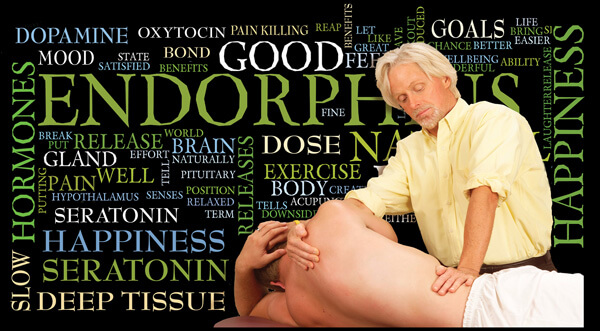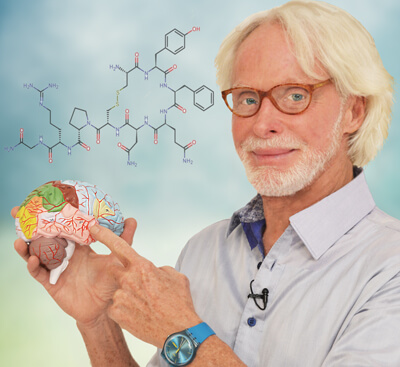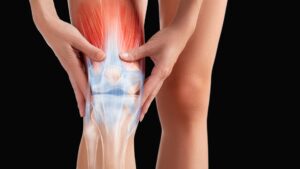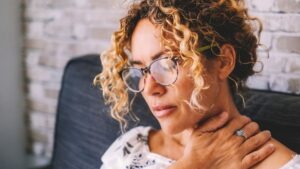Triggering the feel-good hormones through touch
Everyone knows good bodywork feels good, but what causes those feel-good feelings, and how can we further elevate our client’s happiness hormones? To begin, we must understand the neurochemicals associated with bliss. According to Christopher Bergland, author of The Athlete’s Way, the human body is blessed with the ability to produce its own happiness hormones — and there are steps we can take to help trigger their release.

“Life in the human body is designed to be a blissful experience. Our evolutionary biology insures that everything necessary for our survival makes us feel good. All animals seek pleasure and avoid pain,” Bergland states. “Therefore, our brain has a wellspring of self-produced neurochemicals that turn the pursuits and struggles of life into pleasure and make us feel happy.”
One of the side effects of living in a digitally-driven world in times of stress is that our biology is often short-circuited, causing us to be increasingly removed from our innate physicality. As the balance of neurochemicals that have evolved for millennia become disrupted by today’s modern lives, our clients become more prone to depression, anxiety, and pain.
In this blog, we’ll discuss four brain molecules linked to happiness and offer simple ways to help trigger their release. The acronym DOSE (dopamine, oxytocin, serotonin, and endorphins) is used to describe the hormonal quartet responsible for those feel-good feelings, and although there are many ways to stimulate their secretion, we’ll focus on the ones we can get our hands on.

Dopamine: the pleasure-reward hormone
Secreted by the hypothalamus in anticipation of rewards, dopamine is a chemical messenger called a neurotransmitter. It drives our brain’s reward system and stimulates pleasure-seeking behavior, motivating us to take action toward goals, desires, and needs… and giving us a surge of reinforcing pleasure as we achieve them.
Clients love to set and achieve therapeutic goals, from freer movement and posture improvement to enhanced performance and less pain, and we can use our understanding of dopamine to help them get what they want. For starters, break big bodywork goals down into smaller ones, so the client’s brain can celebrate with a hit of dopamine each time it anticipates reaching the finish line. To avoid a dopamine hangover, continue to stimulate the release of this happiness hormone by helping the client set a new goal prior to achieving the current one.
For example, if a client comes to you complaining of a chronic neck crick that’s affecting her sleep and impairing her driving due to lack of head rotation, ask her to make note of how much better her neck feels on the drive home. Just the anticipation of moving better will enhance dopamine production and, in turn, the hands-on work. To keep the feel-good chemicals flowing, instruct her to perform a simple homework exercise, such as staring in the mirror while rotating her shoulders side-to-side. This novel maneuver tricks the brain into believing it can rotate the head without threat. By completing the exercise each night, she will begin to rest more comfortably. To stimulate dopamine at the next session, praise her efforts and encourage her toward achieving her next goal. The pleasure-reward hormone will give her a lift before the hands-on work even begins.
Oxytocin: the feel-good hormone
Good, empathetic bodywork in a warm, friendly environment is just the ticket to help form social bonds that keep the client’s oxytocin flowing. Over a series of sessions, oxytocin enhances intimacy and trust, contributing to healthy client relationships and improved therapeutic outcomes. In fact, researchers have found that interpersonal touch not only stimulates oxytocin release, but also reduces cardiovascular stress and enhances immune function.1
Other studies have concluded that non-vigorous massage with the intent of pampering the client better enhances oxytocin release.2 For best results, I suggest experimenting with various levels of hand pressure during sessions. If the situation permits, give the client a post-therapy hug to stimulate their social chemicals. You’ll find it will provide you both with a feel-good oxytocin buzz.
Serotonin: the happy hormone
Serotonin, another mood-boosting neurotransmitter, was made famous by the invention of SSRI (selective serotonin reuptake inhibitor) antidepressants, which increase the brain’s serotonin levels. This neurotransmitter directly influences dopamine — the chemical that makes your client feel good — so it’s important to know how to trigger it.
The most effective and natural way to boost serotonin is through exercise, biosocial bonding, and good bodywork. Don’t be surprised when the client falls asleep on the therapy table even when receiving vigorous soft-tissue manipulation, as the production of serotonin is a key component of sleep.
Along with your hands-on work, an additional way to get serotonin flowing is by assuring the client they are being heard and respected. It’s important to stay present and engaged from the time they walk in the door.Reflecting on past therapeutic achievements also elevates their mood as they re-live the experience and take pride in the goals they have achieved.
Endorphins: the pain-killing hormones
Endorphins are released by the brain, spinal cord, and pituitary gland in response to stressful situations, perceived threat, or pain. They temporarily buffer pain in much the same way as drugs such as morphine and codeine and are known to bring on feelings of euphoria (runner’s high) during vigorous exercise. Working in conjunction with serotonin, endorphins also help alleviate anxiety and depression.
Researchers have found slow, sustained deep-tissue work best stimulates the release of endorphins, causing the brain to gate the pain. In the beginning, endorphin work only masks the client’s discomfort, but with each session, the brain begins changing its mind about the pain as confidence in the therapeutic intervention increases.
Helping happiness
Our bodies are home to an intricate hormonal system that constantly works for our survival. This system produces feel-good chemicals as the motivation and reward for taking steps toward what’s good for us. Together, these hormones create a desirable brain state that keeps people coming back for more. Since the therapeutic goal of bodywork and corrective exercise is to tilt the balance away from stress and toward relaxation and healing, we can use our hands-on work to help give a boost to these essential happiness hormones.

References
- Gutkowska, J., Jankowski, M., & Antunes-Rodrigues, J. (2014). The role of oxytocin in cardiovascular regulation. Brazilian Journal of Medical and Biological Research, 47(3), 206-214.
- 2. Vigotsky, A., & Bruhns, R. (2015) The role of descending modulation in manual therapy and its analgesic implications: a narrative review. Pain Research and Treatment. doi: 10.1155/2015/292805









